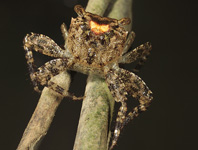Abstract
A new species of Branchinotogluma, found at two hydrothermal vent fields on Southwest Indian Ocean Ridge, is described herein. It can be distinguished from its congeners by the small acicular lobe on the tentacular segment, the stout smooth notochaetae, 5 pairs of dorsal and ventral papillae surrounding the pharynx, 2 pairs of long ventral papillae and 4 pairs of ventral lamellae on males, and modified parapodia on posterior segments. Sexual dimorphism is also reported in the new species, as male and female individuals display differences in characters on the ventral papillae and posterior segments.
References
Desbruyères, D., Segonzac, M. & Bright, M. (2006) Handbook of Deep-Sea Hydrothermal Vent. Zugleich Kataloge der Oberösterreichischen Landesmuseen, Brest, 544 pp.
Dunlap, M. & Adaskaveg, J.E. (1997) Introduction to the Scanning Electron Microscope: Theory, Practice, & Procedures. Presented by Facility for Advanced Instrumentation, U.C. Davis, 51 pp.
Giribet, G., Carranza, S., Baguna, J., Riutort, M. & Ribera, C. (1996) First molecular evidence for the existence of a Tardigrada+Arthropoda clade. Molecular Biology and Evolution, 13 (1), 76–84.
https://doi.org/10.1093/oxfordjournals.molbev.a025573Madison, W.P. & Madison, D.R. (2011) Mesquite: A modular system for evolutionary analysis. Version 3.04. Available from: http:// http://www.mesquiteproject.org (accessed 15 December 2015)
Miura, T. & Hashimoto, J. (1991) Two new branchiate scale-worms (Polynoidae: Polychaeta) from the hydrothermal vent of the Okinawa Trough and the volcanic seamount off Chichijima Island. Proceedings of the Biological Society of Washington, 104, 166–174.
Miura, T. & Desbruyères, D. (1995) Two new species of Opisthotrachopodus (Polychaeta: Polynoidae: Branchinotogluminae) from the Lau and the North Fiji Back-arc Basins, southwestern Pacific Ocean. Proceedings of the Biological Society of Washington, 108, 583–595.
Palumbi, S.R. (1996) Nucleic acids II: The polymerase chain reaction. In: Hillis, D.M., Moritz, C. & Mable, B.K. (Eds.), Molecular Systematics. Sinauer Associates, Sunderland, MA, pp. 205–247.
Pettibone, M.H. (1985) Additional branchiate scale-worms (Polychaeta: Polynoidae) from Galapagos hydrothermal vent and rift-area off Western Mexico at 21°N. Proceedings of the Biological Society of Washington, 98, 447–469.
Pettibone, M.H. (1988) New species and new records of scaled polychaetes (Polychaeta: Polynoidae) from hydrothermal vents of the Northeast Pacific Explorer and Juan de Fuca Ridges. Proceedings of the Biological Society of Washington, 101, 192–208.
Pettibone, M.H. (1989) New species of scale-worms (Polychaeta: Polynoidae) from the hydrothermal rift-area of the Mariana Back-arc Basin in the Western Central Pacific. Proceedings of the Biological Society of Washington, 102, 137–153.
Read, G. & Fauchald, K. (2018) World Polychaeta database. Branchinotogluma Pettibone, 1985. Available from: http://www.marinespecies.org/aphia.php?p=taxdetails&id=324929 (accessed 9 April 2018)
Sarrazin, J., Legendre, P., Busserolles, F.D., Fabri, M.C., Guilini, K., Ivanenko, V.N., Morineaux, M., Vanreusel, A. & Sarradin, P.M. (2015) Biodiversity patterns, environmental drivers and indicator species on a high-temperature hydrothermal edifice, Mid-Atlantic Ridge. Deep Sea Research Part II Topical Studies in Oceanography, 121, 177–192.
https://doi.org/10.1016/j.dsr2.2015.04.013Stamatakis, A. (2014) RaxML version 8: A tool for phylogenetic analysis and post-analysis of large phylogenies. Bioinformatics, 30 (9), 1312–1313.
https://doi.org/10.1093/bioinformatics/btu033Watanabe, H. & Beedessee, G. (2015) Vent fauna on the Central Indian Ridge. In: Ishibashi, J.-I., Okino, K. & Sunamura, M. (Eds.), Subseafloor Biosphere Linked to Hydrothermal Systems: TAIGA Concept. Springer Japan, Tokyo, pp. 205–212.
https://doi.org/10.1007/978-4-431-54865-2_16Zhang, Y., Chen, C. & Qiu, J. (2018a) Sexually dimorphic scale worms (Annelida: Polynoidae) from hydrothermal vents in the Okinawa Trough: Two new species and two new sex morphs. Frontiers in Marine Science, 5, 112.
https://doi.org/10.3389/fmars.2018.00112Zhang, Y., Sun, J., Rouse, G.W., Wiklund, H., Pleijel, F., Watanabe, H.K., Chen, C., Qian, P. & Qiu, J. (2018b) Phylogeny, evolution and mitochondrial gene order rearrangement in scale worms (Aphroditiformia, Annelida). Molecular Phylogenetics and Evolution, 125, 220–231.
https://doi.org/10.1016/j.ympev.2018.04.002Zhou, Y., Zhang, D., Lu, B. & Wang, C. (2017) Description of a new branchiate scale-worm (Polychaeta: Polynoidae) from the hydrothermal vent on Southwest Indian Ocean Ridge. Zootaxa, 4282 (1), 123–134.
https://doi.org/10.11646/zootaxa.4282.1.7Zhou, Y., Zhang, D., Zhang, R., Liu, Z., Tao, C., Lu, B., Sun, D., Xu, P., Lin, R., Wang, J. & Wang, C. (2018) Characterization of vent fauna at three hydrothermal vent fields on the Southwest Indian Ridge: implications for biogeography and interannual dynamics on ultraslow-spreading ridges. Deep-Sea Research Part I, 137, 1–12.
https://doi.org/10.1016/j.dsr.2018.05.001

